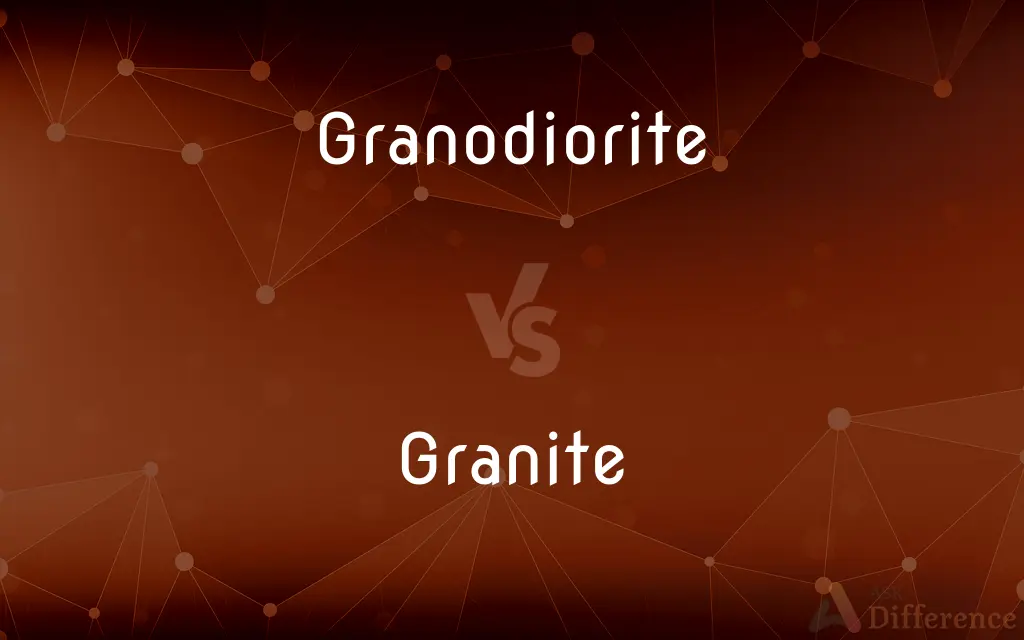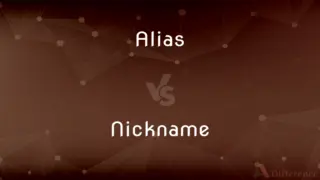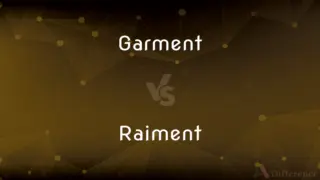Granodiorite vs. Granite — What's the Difference?
By Maham Liaqat & Urooj Arif — Updated on March 29, 2024
Granodiorite is a coarse-grained igneous rock with more plagioclase feldspar than orthoclase, whereas granite is also coarse-grained but rich in orthoclase feldspar and quartz.

Difference Between Granodiorite and Granite
Table of Contents
ADVERTISEMENT
Key Differences
Granodiorite is an intrusive igneous rock, characterized by a significant amount of plagioclase feldspar compared to potassium feldspar (orthoclase), giving it a more subdued color. Granite, on the other hand, contains a higher proportion of potassium feldspar, which adds to its typically lighter coloration and grainy appearance.
While both rocks are formed from the cooling and solidification of magma beneath the Earth's surface, the composition of the magma for each rock type leads to differences in mineral content. Granite is rich in quartz and orthoclase feldspar, making it predominantly light in color, whereas granodiorite, with its higher plagioclase content, often appears darker.
The texture of granodiorite and granite is similar, with both displaying a coarse-grained structure that allows individual minerals to be visible to the naked eye. However, the specific mineral assemblage within each rock can affect its overall appearance and physical properties.
Granodiorite is often found in continental crust environments where it contributes to the foundation of continents, similar to granite. However, the geological processes leading to the formation of granodiorite often involve more interaction between oceanic and continental crust, which influences its mineral composition.
In practical applications, both granite and granodiorite are valued for their durability and beauty, making them popular choices for construction, monuments, and decorative stone. However, the choice between the two can depend on aesthetic preference and specific engineering properties.
ADVERTISEMENT
Comparison Chart
Main Minerals
Plagioclase feldspar > Orthoclase feldspar
Orthoclase feldspar > Plagioclase feldspar
Color
Generally darker, due to plagioclase content
Lighter, with a predominance of quartz and orthoclase
Formation
From magma with intermediate silica content
From magma with high silica content
Texture
Coarse-grained, visible minerals
Coarse-grained, visible minerals
Typical Use
Construction, monuments, decorative stone
Construction, monuments, decorative stone
Compare with Definitions
Granodiorite
A coarse-grained igneous rock with a mix of plagioclase and potassium feldspar.
The city hall's steps are made of durable granodiorite.
Granite
A light-colored, coarse-grained igneous rock rich in quartz and feldspar.
The kitchen features countertops made of polished granite.
Granodiorite
Formed from magma beneath the Earth's surface.
Granodiorite formations are common in areas with ancient volcanic activity.
Granite
Often appears in lighter shades due to its mineralogy.
The granite cliff gleamed in the sunlight, highlighting its speckled surface.
Granodiorite
Darker than granite due to its mineral composition.
The sculptor chose granodiorite for the statue for its somber aesthetic.
Granite
Intrusive rock formed from cooled magma.
Granite outcrops provide clues about the Earth's continental crust.
Granodiorite
Found in continental crust environments.
The mountain range consists largely of granodiorite.
Granite
Widely used in building, monuments, and for decorative purposes.
The ancient temple was constructed entirely of granite blocks.
Granodiorite
Used in construction and as decorative stone.
Granodiorite countertops are prized for their unique patterns.
Granite
Predominantly composed of quartz and orthoclase feldspar.
Granite's durability comes from its hard quartz content.
Granodiorite
Granodiorite () is a coarse-grained (phaneritic) intrusive igneous rock similar to granite, but containing more plagioclase feldspar than orthoclase feldspar. The term banatite is sometimes used informally for various rocks ranging from granite to diorite, including granodiorite.
Granite
Granite () is a coarse-grained igneous rock composed mostly of quartz, alkali feldspar, and plagioclase. It forms from magma with a high content of silica and alkali metal oxides that slowly cools and solidifies underground.
Granodiorite
A coarse-grained igneous rock consisting primarily of quartz, plagioclase feldspar, and potassium feldspar, and also containing biotite, hornblende, or pyroxene.
Granite
A common, coarse-grained, light-colored, hard igneous rock consisting chiefly of quartz, orthoclase or microcline, and mica, used in monuments and for building.
Granodiorite
(rock) An intrusive igneous rock similar to granite, but containing more plagioclase than potassium feldspar.
Granite
Unyielding endurance; steadfastness
A will of granite.
Granite
(rock) A group of igneous and plutonic rocks composed primarily of feldspar and quartz. Usually contains one or more dark minerals, which may be mica, pyroxene, or amphibole. Granite is quarried for building stone, road gravel, decorative stone, and tombstones. Common colors are gray, white, pink, and yellow-brown.
Granite
Toughness; the quality of having a thick skin or being rough.
Granite
A crystalline, granular rock, consisting of quartz, feldspar, and mica, and usually of a whitish, grayish, or flesh-red color. It differs from gneiss in not having the mica in planes, and therefore in being destitute of a schistose structure.
Granite
Plutonic igneous rock having visibly crystalline texture; generally composed of feldspar and mica and quartz
Granite
Something having the quality of granite (unyielding firmness);
A man of granite
Common Curiosities
How is granite different from granodiorite?
Granite is richer in quartz and orthoclase feldspar, giving it a lighter color and slightly different mineral composition.
What are the common uses of granite?
For construction, decorative stone, and monuments, valued for its beauty and durability.
Where is granodiorite typically found?
In continental crust environments, often associated with tectonic activity between oceanic and continental plates.
Why choose granodiorite over granite for certain projects?
Due to its unique coloration and texture, which may be preferred for aesthetic or specific architectural reasons.
What makes granite so durable?
Its high quartz content and interlocking crystal structure contribute to its hardness and resistance to weathering.
Can granite and granodiorite be used interchangeably?
While they can be used for similar applications, their different appearances and properties may make one more suitable than the other for certain designs.
Is granodiorite more expensive than granite?
Costs can vary depending on availability, location, and demand, rather than intrinsic properties of the rock itself.
How are the textures of granite and granodiorite similar?
Both exhibit a coarse-grained texture, with large, visible crystals.
What minerals are typically found in granodiorite?
Apart from plagioclase feldspar, it may contain quartz, biotite, and amphiboles.
What is granodiorite?
An intrusive igneous rock with a higher content of plagioclase feldspar than potassium feldspar, making it generally darker.
How are granite and granodiorite formed?
Both are formed from the cooling and solidification of magma beneath the Earth’s surface, but with different compositions.
Why is granite preferred for kitchen countertops?
Its durability, resistance to heat, and aesthetic appeal make it ideal for kitchens.
Do granite and granodiorite require special maintenance?
Both are relatively low maintenance but may require sealing to prevent staining and to maintain their appearance.
What geological processes lead to the formation of granite?
It forms from the slow cooling of magma with a high silica content, deep within the Earth's crust.
How does the color of granodiorite affect its use?
Its darker color can offer a dramatic look, suitable for certain architectural and design preferences.
Share Your Discovery

Previous Comparison
Alias vs. Nickname
Next Comparison
Garment vs. RaimentAuthor Spotlight
Written by
Maham LiaqatCo-written by
Urooj ArifUrooj is a skilled content writer at Ask Difference, known for her exceptional ability to simplify complex topics into engaging and informative content. With a passion for research and a flair for clear, concise writing, she consistently delivers articles that resonate with our diverse audience.
















































